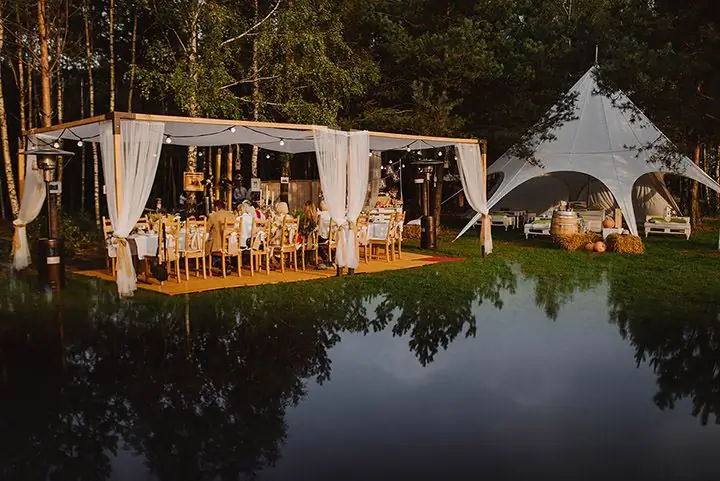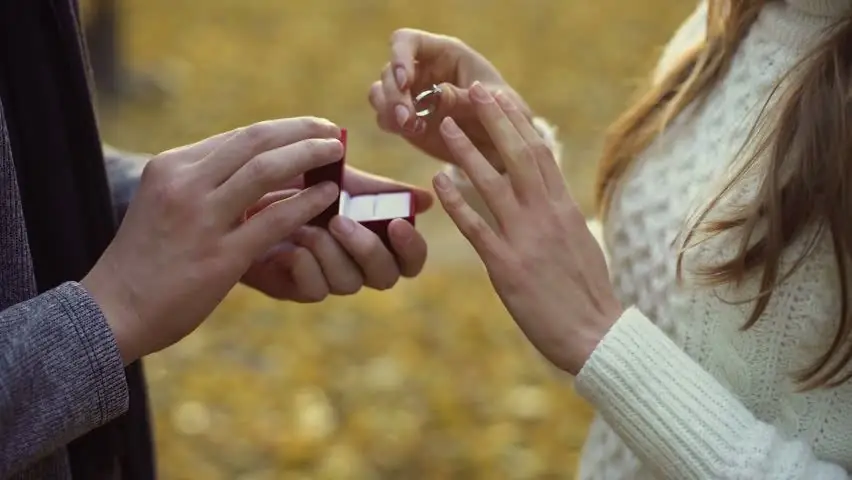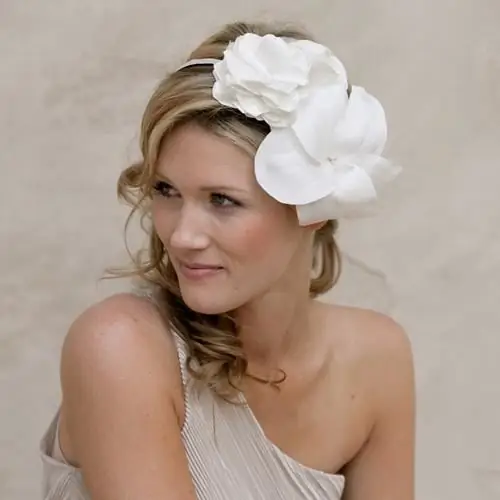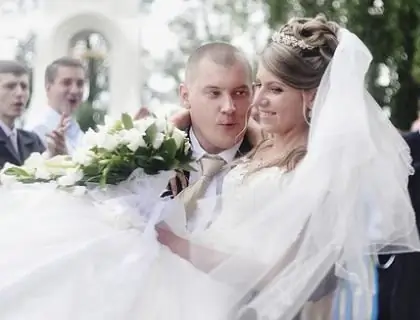2025 Author: Priscilla Miln | [email protected]. Last modified: 2025-01-22 17:55:19
The presence of a variety of wedding rites of the peoples of the world testifies to the important role that the institution of marriage has played and continues to play in the life of society. As a rule, the observance of certain rituals concerns not only the wedding itself, but also other events related to it, from marriage proposal to engagement.
Wedding ceremonies and customs that existed among the Slavs in antiquity and modern rituals are interconnected. The second ones are a continuation of the first ones and have great similarities with them, although life has changed a lot since those times. Below we will consider both the traditions of the ancient Slavs and modern Russian rituals, as well as some Western customs.
The system of ancient wedding traditions
Wedding ceremonies in Russia are a whole complex of traditions, formed in the process of people's life. All of them are closely interconnected, consistent, follow one from the other and have a certain reason for their occurrence, which is explained by the existing beliefs and facts of economic life.
This system of wedding rites was formed around the 15th century. It includes a number of steps such as:
- Matchmaking.
- Viewing the economy.
- Collusion.
- Crying (or howling).
- Bachelorette party (bachelor party).
- Ransom of the bride.
- Wedding ceremony.
- Fun.
- Wedding feast.
Wedding ceremonies of the Slavs include many different elements, including: a mandatory set of actions of characters (bride, groom, boyfriends), cries (crying), dances, ritual songs. Next, consider how the wedding celebration itself was held.
First wedding day - sequence of events
The history of the wedding rites of the Slavs tells that the following events took place on the first day:
- Arrival of the groom for the bride.
- Following the crown.
- Moving the dowry.
- Arrival of the couple at the groom's house.
- Parental blessing.
- Feast.

In some areas there were other scenarios. So, for example, in the northern regions, the following scheme of wedding ceremonies of the first day was used:
- Going to the bath.
- Communication between bride and bridesmaids.
- Arrival of the groom at the bride's house.
- Bringing the young to her future husband and guests.
- Regaling guests.
The main thing in the second scenario was the presentation of the bride to the public. This ancient wedding ceremony was also called "bringing before the tables." The young one was dressed up especially beautifully, performing overher magical actions (a conspiracy for happiness and good luck). On the first day, all the guests stayed overnight in the house, and the bride and groom were supposed to sleep together. This meant that the wedding itself, as such, took place. On the second day, such events of the wedding ceremony took place as the wedding ceremony in the church and the feast in the groom's house.
The role of the buddy
Druzhka (another option - Druzhko) was one of the most important participants in the ritual. As a rule, he was chosen from the groom's relatives, for example, it was his friend or brother. In some cases, there could be two or three such figures, but the main one was necessarily appointed. An indispensable accessory of the groom's attire was an embroidered wedding towel, which was tied over the shoulder. Sometimes two of them were tied at once.
Despite the fact that each of the participants in the ceremony knew the order of its conduct, the friend was assigned the role of leader. He monitored the correctness and sequence of actions and, if necessary, prompted the actors when to lament, dance, sing, redeem the bride. Wedding ceremonies in Russia involved caustic jokes about the boyfriend, to which he had to give a decent response in a similar vein. As for the groom, he did not say much at the wedding.
Arrival of the groom
On the morning of the first wedding day, a boyfriend first drove to the bride's house to make sure she was ready for her betrothed's visit. Young by this time should have dressed up and be in the red corner.
After that, a wedding train was sent to the bride's house, consisting of a boyfriend, groom, his friends and relatives. They arethey sang special wedding songs called “poezzhanskie”.
After the arrival of the groom, the entrance to the house was purchased, which was made either by himself or by a friend. It could be one ransom or several, for example, gates, doors, a path to the house were redeemed.
Bride price
The ransom of the bride at the wedding is one of the essential elements of the ceremony, which has been preserved to this day and is very popular. She is redeemed either from her friends, or from her father and mother. At the same time, the girl is hidden until the money is paid by the groom.
It used to be a custom to deceive a future husband. The bride was taken to him, on which a scarf made of dense fabric was thrown over, before he played the role of a modern transparent veil. To look at the narrowed one, it was necessary to deposit the required amount of money. Sometimes the bride was replaced by another girl or even an elderly woman, which caused merry laughter and the need for a second ransom.
Before and after the wedding
Before going to church for the wedding ceremony, the mother and father of the bride blessed the newlyweds, holding an icon in their hands. Then they were offered to break bread with s alt. After that, the bride was untwisted "maiden's" braid.

When the already married couple returned to the house after the completion of the church ceremony, the following happened. The girl was braided with two braids, which were considered "woman's", and her hair was hidden under a special headdress - a warrior. There were options when this was done during a feast or, like the Old Believers, between the rituals of betrothal and wedding, orbefore the engagement.
After the wedding, the groom took the bride to his home, where the bridegroom's parents blessed the young - also with icons and bread and s alt. In ancient times, there was a tradition with pagan roots, the essence of which was that those who arrived from the church were seated on a fur coat. The skin of an animal (often a bear) acted as a talisman. Bread, which was bitten by both the groom and the bride, was also attributed magical significance. Later, it was given to a cow, which was supposed to bring a good offspring.
Rules for the feast
The feast was held in the groom's house, where the tables were set for the arrival of the guests. Between the food and the libations, the solemn wedding songs were sung. In addition to the bride and groom, their parents and boyfriend were welcomed in them.

The celebration could last from two to three days. The second day of the wedding feast was held at the bride's house. If the festivities dragged on for another day, then the guests, the heroes of the occasion and their parents again went to the groom.
Image of a bear
As folk beliefs say, the bear is a talisman against evil spirits, evil spirits "cannot stand" his appearance. Therefore, a man was present at the weddings, on whom a bearskin was thrown, and he symbolically protected the young from all evil spirits.
Later, the bear was credited with a beneficial effect on strengthening the reproductive function, which even more determined the presence of his image at the wedding ceremony.
The bride and groom were called "bear" and "bear", often onthey spent their first night together on a bearskin. This sacred animal was a marriage symbol not only during pagan times, but remained so with the transition to the Christian faith.
Other protective rites
In addition to the presence of the image of a bear at the wedding, there were other rituals designed to protect the young family.

Here are some of them:
- In order to "mislead" the dark forces during the matchmaking period, it was necessary to get to the bride's house in a roundabout way.
- During the entire route of the wedding train in the direction of the church, the sound of bells in a horse harness was heard, protecting from all evil spirits.
- Young people were led around a tree or a pole to "turn their heads" to otherworldly "ill-wishers".
- The groom had to carry the bride into the house in his arms, without stepping on the threshold. Thus, the brownie agreed to accept her into a new family.
- Before you sit down at the table, you had to abstain from food - it helped to protect yourself from spoilage. It was also forbidden to use foul language at the wedding.
- Sprinkling the bride and groom with grains of cereals or hops was intended to attract we alth to the house and contribute to the birth of many children in the family.
- To strengthen the bond between future husband and wife, they mixed wine from their glasses, pulled strings between their houses, tied their hands with a wedding towel.
Laying down and waking up the young
The bride and groom were put to bed either in the evening or at night. The marriage bed that the groomwas obliged to redeem, the matchmaker or the bed was preparing. The latter was chosen from among the relatives of the bride, she guarded the bedding from damage at the time when the dowry was delivered from the house of the girl's parents to the groom, as well as during the feast. When “selling”, she filled the price, which could exceed the “value” of the bride herself.

In the morning or after several hours, the mother-in-law, matchmaker or boyfriend woke up the young couple. Often, guests would then be presented with evidence that the bride was a virgin, showing off her nightgown or bed sheet.
Another way to demonstrate the girl's innocence was the groom's answers to ritual questions or eating scrambled eggs, pie, pancake from the middle or from the edge. If the girl did not justify the hopes for "honesty", then she herself, her parents, could be ridiculed, they could put a collar around their neck, smear the gate with tar.
Second day of festivities

Usually, the second day of the wedding was dedicated to various wedding ceremonies, such as the following:
- Searching for a yarochka. It consisted in the fact that the “yarochka”, that is, the sheep that the bride portrayed, was hiding in the house, and the person representing the “shepherd” was looking for her. It was one of the relatives, guests, or all those gathered together.
- A young woman's trip through the water with two oars attached to the yoke, which spoke of her dexterity.
- Sweeping floors. The guests scattered around money, grain, garbage. The newly-made wife had to do a thorough cleaning, whichothers were judging.
- The groom's visit to the mother-in-law's house, which was called "Khlibins", "Yashnya". His mother-in-law treated him to scrambled eggs or pancakes, which were covered with a scarf. Above the handkerchief, the son-in-law put money, buying food.
- Riding around the village. The guests dressed up in clothes that were playful, grotesque, pretended to be various folklore characters.
- Splitting viburnum. A ham and a vessel with wine were placed on the table for young people, which were plugged with a bundle of straw and tied with a scarlet ribbon. After waking up the young, they go to regale relatives and friends in their homes. Upon the return of the friend, he “destroyed” the ham, “splitted” the viburnum, distributing the wine.
- Sending viburnum. If the bride turned out to be chaste, then her parents were sent a bottle of wine, to which they attached a viburnum branch and ears of corn. Kalina symbolized the "honesty" of the bride and was called her "beauty". If the bride was “dishonest”, viburnum decorations were removed from everywhere: from the loaf, from the walls, and pine branches were stuck in their place.
Modernity and tradition
In today's reality, modern wedding ceremonies include both new rituals and adherence to ancient traditions. As a rule, the ceremony of matchmaking is not observed, the young people agree among themselves, and their parents are simply informed. For the wedding, they buy wedding rings, a dress for the bride (usually white), a veil or a hat that replaces it, an elegant suit for the groom (most often classic).

By analogy with the wedding train among the Slavs, modern Russianthe bride and groom with friends and witnesses arrive at the place of marriage on a rented transport, decorated with balls, ribbons, dolls, enlarged models of wedding rings. Often a white limousine acts as a wedding car.
Registration at the registry office
Marriage registration takes place in the registry office or more solemnly, in the Wedding Palace specially designed for this ceremony. It is carried out by civil servants under the march of Mendelssohn, with the wishes of a happy family life. At the same time, guests are present, among whom are witnesses from the side of the bride and groom, confirming their signatures.
According to the results of the ceremony, during which each of the spouses expresses their consent to become husband and wife, a marriage certificate is issued. Recently, more and more couples decide to seal their relationship with a wedding ceremony in the temple. But this is not necessarily done at the time of the wedding, sometimes even after several years of married life.
Champagne and bridal bouquet
At the completion of the registration ceremony, the bride and groom become husband and wife. They are congratulated on this significant event, they drink champagne and break glasses “for good luck”. Money, grains of rice or wheat are thrown at their feet, which clearly echoes an old custom and symbolizes the attraction of we alth and fertility of the couple into the house.
The tradition of throwing the bride's bouquet also originates in antiquity. Previously, the groom himself collected certain flowers in the field, which were a symbol of certain benefits that he wished for himself and his beloved, for example,such as longevity, fidelity, devotion. The girl pressed the bouquet to her chest. Throwing a bouquet began not so long ago, taking an example from Western newlyweds. It is believed that the girl who caught him will get married within the next year.
Dance of the young at the wedding
At the ancient Slavic wedding, of course, it was not without dancing. But special attention has been paid to the dance of the bride and groom only recently. The tradition concerning the dance of the young at the wedding, as well as the throwing of the bouquet, came to us from the countries of the West. As a rule, this is a classic w altz.
However, this is not a dogma, in an effort to bring originality to the wedding ceremony, young people also choose fast, temperamental dances, such as tango. And also it can be modern original compositions. Dances are specially learned before the wedding, turning to professionals for help.
Veil of the ancient Slavs
The veil itself was not transparent before, it was a scarf made of dense fabric of bright, often red color. As you know, red means beautiful. The role of this scarf was to protect the bride, while she had not yet become a wife, from damage and the evil eye.
According to the ideas of our ancestors, along with the visible and tangible world, there was a world of evil spirits that constantly pursued a person, and it was necessary to defend against it. As mentioned above, the bride was taken out to the guests in a scarf that completely covered her face and hair. And only after the groom redeemed her, the scarf was removed.
Wedding ceremony "Removing the veil"
This riteis a synthesis of old Slavic and new Western traditions. Nowadays it looks like this:
- It is held closer to the end of the wedding celebrations.
- The bride's veil is removed by the groom's mother, her future mother-in-law.
- After the bride dances with her father, candles are handed out to guests.
- The father passes the bride to the future son-in-law, admonishing to love, respect and protect her throughout their family life.
- A chair is placed in the middle of the room, on which a pillow is placed, which is a symbol of the spiritual and physical connection of the newlyweds, the harmonious relationship between them.
- The groom sinks into a chair, placing his beloved on his lap.
- Guests with lit candles surround the newlyweds.
- The mother-in-law approaches the bride, removes hairpins from the veil and removes it from the girl.
- The last hairpin is passed from the mother to her son, which symbolizes the arrival of a new mistress in the house.
- At the end, the mother of the bride puts a headscarf on her, seeing her off to a happy married life.
From the story about the ancient Slavic and modern Russian wedding rites, it is clear that the latter are often intertwined with the former, flow from them, which decorates today's wedding ceremonies, making them more diverse and spiritually richer. And there is also a connection with Western traditions, which are positively perceived by today's youth.
Recommended:
Slavic wedding: description, traditions, customs, outfits of the bride and groom, decoration of the hall and table

Wedding is an incredibly important event in the life of every person, requiring careful preparation and marking a new stage in the life and relationships of lovers. Ancestors treated this event with due respect and awe, and therefore it is not surprising that the traditions of the Slavic wedding are attractive for those who get engaged today
What is the difference between engagement rings and wedding rings? How to choose wedding and engagement rings?

When going to a jewelry store, remember that this ring may become a family heirloom in the future and be passed down to descendants through many generations. Therefore, approach the choice of product, start with all seriousness. Most likely, few gentlemen will be able to immediately answer the question of what is the difference between an engagement and a wedding ring
DIY wedding accessories. Wedding rings on the car. Wedding cards. wedding champagne

Wedding accessories are an integral part of holding festive ceremonies and creating the image of the groom, bride, witnesses. Such trifles can be purchased in specialized stores or salons, made independently or made to order from the master, according to your preferences, the theme of the event and the color scheme
Old and new wedding traditions and rituals

Today in our country at the wedding there are various wedding traditions and rituals. But not everyone knows what most of them mean, but they are simply performed mechanically, because “it’s necessary,” the toastmaster said so. Many will be interested to know what lies at the root of a particular tradition. This information can be found in the article
The best wedding traditions in Russia. Wedding customs in Russia

How did wedding traditions develop in Russia? Which of them do the newlyweds try to observe, and which have long remained only a beautiful custom? Read more about this and more

